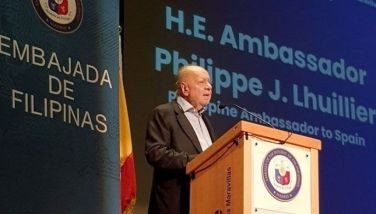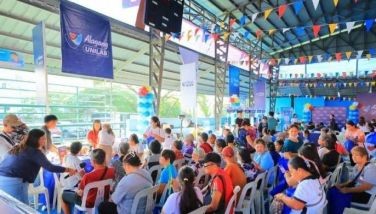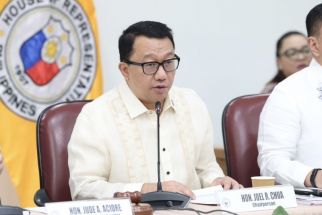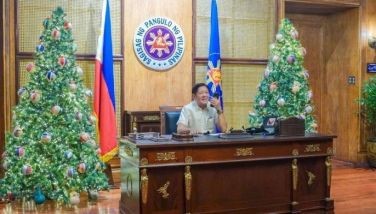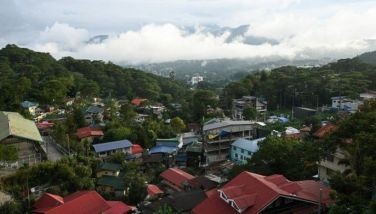How do RP media cover terrorism?
April 27, 2002 | 12:00am
Chairperson, Communication
UNESCO National Commission of the Philippines
A roundtable meeting on "Terrorism and the Media" was held early April as a pre-conference activity for the May 1 and 2 International Conference for the World Press Freedom Day Celebration organized by the UNESCO in coordination with the UNESCO National Commission of the Philippines on the same topic.
Participants which included journalists, members of academe and press freedom rights activists "revisited" age-old issues such as adequacy of media coverage, safety and protection of journalists, professionalization, as well as legal and ethical issues. But this time the focus was on a global issue which President Arroyo referred to as one of the two serious national problems today – terrorism. The other one of course is poverty which can be seen as one of the root causes of terrorism as well as a consequence of the escalation of violence and conflict.
In both the earlier press conference and this meeting which is a pre-international conference workshop, the issue of definition of terrorism again surfaced. How one defines terrorism fluctuates depending on the position of the occupying power or his adversary, a law expert noted. One country’s terrorist is another country’s freedom fighter is a saying that is illustrated by examples of changes in perceptions about certain leaders of national liberation movements. One example is that of Nelson Mandela of South Africa, one of the most respected leaders who was once described as a terrorist in his own country. Even UN Secretary General Kofi Annan acknowledged terrorism as one of the most difficult issues and understands the need for legal precision. Because of varying interpretations of this concept, it is understandable why to this date, many journalists find it difficult to prepare think pieces on this issue. According to Kapisanan ng mga Brodkaster sa Pilipinas executive director Rey Hulog, there is no mention of terrorism in the KBP Code of Ethics. It is therefore difficult to monitor violations in reporting until a specific provision on the issue is integrated in the broadcast code. The same is true for print media.
News stories usually focus on the four W’s – Who, What, Where and When but the Why is often overlooked. The few stories which answer the Why do not provide comprehensive information, according to former Press Secretary Rod Reyes. For example, he asks: Why is it that the Muslim youth are interested in joining the Abu Sayyaf? Why was the Libyan government involved in the Sipadan hostage negotiation?
Melinda de Jesus, executive director of the Center for Media Freedom and Responsibility, explains this "events" orientation in terms of existing perspectives of news editors who tend to cater to what the market or public demands. Most articles emphasize the obvious and do not delve into issues, especially the contentious ones. And the audience does not seem to complain about the shallow treatment of stories and the lack of in-depth articles. A clearer demarcation of the following news processes – newsgathering, interpretation and persuasion is needed as it is difficult to distinguish one from the other, she added.
Datu Michael Mastura of the Sultan Kudarat Islamic Academy explains this imbalance in media coverage as a consequence of the "Manila-centricness" of media agencies. Manila desks, he noted, use very little of information fed by their provincial correspondents. Philippine media is very parochial and compared with the other Asean media, we carry very few stories about the region.
The political economy of the country is a critical factor in helping us understand media coverage of terrorism. Excessive commercialism which has characterized Philippine media all these past decades has successfully marginalized non-entertainment stories on topics like terrorism. Ownership determines editorial content. Because most media enterprises appear to be primarily concerned with profit and the bottom line, Rod Reyes suggests that we should "bring back the wall which divides the newsroom and profit center."
This pervasive emphasis on entertainment to a large extent has prevented media from becoming more reflective and analytical. Because one has to appeal to the average reader or viewer, there is a tendency to slant news stories and to resort to stereotypes. For example, we still read about "Muslim bandits" not Christian kidnappers. Or "Palestinian gunmen" but we describe the other group as Israeli fighters.
An interesting perspective was shared by Saeed Daof, an MILF adviser. He asked: Is it possible that the Abu Sayyaf is merely a creation of the media? Initially, the Abu Sayyaf group consisted of only two to three families. But media had given the group considerable coverage and tended to "romanticize" them. He reinforced Mastura’s comment on the Manila-centric nature of reporting by asking: If news events like kidnapping happened in Luzon, will the Manila media provide the same degree of coverage? Will the stories also hog the headlines? (To be continued)
UNESCO National Commission of the Philippines
Participants which included journalists, members of academe and press freedom rights activists "revisited" age-old issues such as adequacy of media coverage, safety and protection of journalists, professionalization, as well as legal and ethical issues. But this time the focus was on a global issue which President Arroyo referred to as one of the two serious national problems today – terrorism. The other one of course is poverty which can be seen as one of the root causes of terrorism as well as a consequence of the escalation of violence and conflict.
In both the earlier press conference and this meeting which is a pre-international conference workshop, the issue of definition of terrorism again surfaced. How one defines terrorism fluctuates depending on the position of the occupying power or his adversary, a law expert noted. One country’s terrorist is another country’s freedom fighter is a saying that is illustrated by examples of changes in perceptions about certain leaders of national liberation movements. One example is that of Nelson Mandela of South Africa, one of the most respected leaders who was once described as a terrorist in his own country. Even UN Secretary General Kofi Annan acknowledged terrorism as one of the most difficult issues and understands the need for legal precision. Because of varying interpretations of this concept, it is understandable why to this date, many journalists find it difficult to prepare think pieces on this issue. According to Kapisanan ng mga Brodkaster sa Pilipinas executive director Rey Hulog, there is no mention of terrorism in the KBP Code of Ethics. It is therefore difficult to monitor violations in reporting until a specific provision on the issue is integrated in the broadcast code. The same is true for print media.
News stories usually focus on the four W’s – Who, What, Where and When but the Why is often overlooked. The few stories which answer the Why do not provide comprehensive information, according to former Press Secretary Rod Reyes. For example, he asks: Why is it that the Muslim youth are interested in joining the Abu Sayyaf? Why was the Libyan government involved in the Sipadan hostage negotiation?
Melinda de Jesus, executive director of the Center for Media Freedom and Responsibility, explains this "events" orientation in terms of existing perspectives of news editors who tend to cater to what the market or public demands. Most articles emphasize the obvious and do not delve into issues, especially the contentious ones. And the audience does not seem to complain about the shallow treatment of stories and the lack of in-depth articles. A clearer demarcation of the following news processes – newsgathering, interpretation and persuasion is needed as it is difficult to distinguish one from the other, she added.
Datu Michael Mastura of the Sultan Kudarat Islamic Academy explains this imbalance in media coverage as a consequence of the "Manila-centricness" of media agencies. Manila desks, he noted, use very little of information fed by their provincial correspondents. Philippine media is very parochial and compared with the other Asean media, we carry very few stories about the region.
The political economy of the country is a critical factor in helping us understand media coverage of terrorism. Excessive commercialism which has characterized Philippine media all these past decades has successfully marginalized non-entertainment stories on topics like terrorism. Ownership determines editorial content. Because most media enterprises appear to be primarily concerned with profit and the bottom line, Rod Reyes suggests that we should "bring back the wall which divides the newsroom and profit center."
This pervasive emphasis on entertainment to a large extent has prevented media from becoming more reflective and analytical. Because one has to appeal to the average reader or viewer, there is a tendency to slant news stories and to resort to stereotypes. For example, we still read about "Muslim bandits" not Christian kidnappers. Or "Palestinian gunmen" but we describe the other group as Israeli fighters.
An interesting perspective was shared by Saeed Daof, an MILF adviser. He asked: Is it possible that the Abu Sayyaf is merely a creation of the media? Initially, the Abu Sayyaf group consisted of only two to three families. But media had given the group considerable coverage and tended to "romanticize" them. He reinforced Mastura’s comment on the Manila-centric nature of reporting by asking: If news events like kidnapping happened in Luzon, will the Manila media provide the same degree of coverage? Will the stories also hog the headlines? (To be continued)
BrandSpace Articles
<
>
- Latest
- Trending
Trending
Latest
Trending
Latest
Recommended












